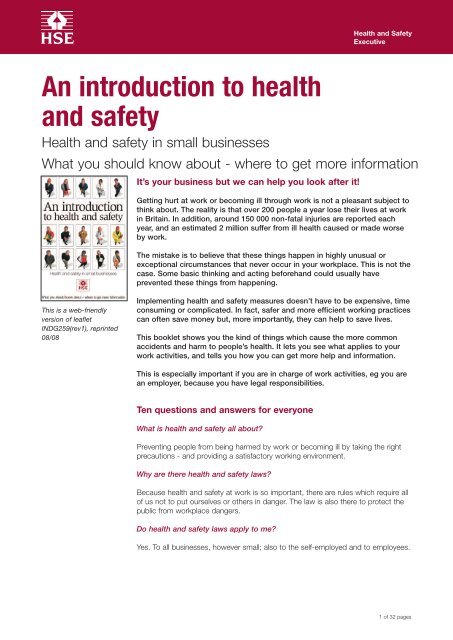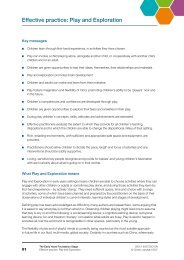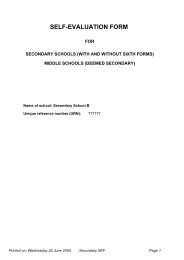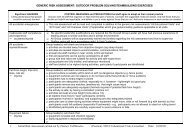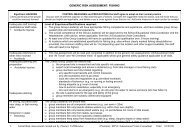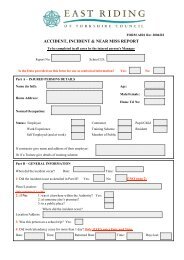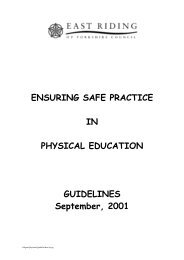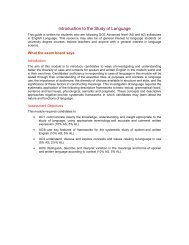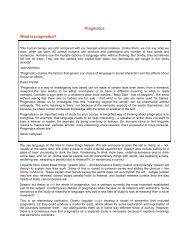An introduction to health & safety in small businesses - BJB Fork Lift ...
An introduction to health & safety in small businesses - BJB Fork Lift ...
An introduction to health & safety in small businesses - BJB Fork Lift ...
You also want an ePaper? Increase the reach of your titles
YUMPU automatically turns print PDFs into web optimized ePapers that Google loves.
Health and Safety<br />
Executive<br />
<strong>An</strong> <strong><strong>in</strong>troduction</strong> <strong>to</strong> <strong>health</strong><br />
and <strong>safety</strong><br />
Health and <strong>safety</strong> <strong>in</strong> <strong>small</strong> bus<strong>in</strong>esses<br />
What you should know about where <strong>to</strong> get more <strong>in</strong>formation<br />
It’s your bus<strong>in</strong>ess but we can help you look after it!<br />
Gett<strong>in</strong>g hurt at work or becom<strong>in</strong>g ill through work is not a pleasant subject <strong>to</strong><br />
th<strong>in</strong>k about. The reality is that over 200 people a year lose their lives at work<br />
<strong>in</strong> Brita<strong>in</strong>. In addition, around 150 000 nonfatal <strong>in</strong>juries are reported each<br />
year, and an estimated 2 million suffer from ill <strong>health</strong> caused or made worse<br />
by work.<br />
The mistake is <strong>to</strong> believe that these th<strong>in</strong>gs happen <strong>in</strong> highly unusual or<br />
exceptional circumstances that never occur <strong>in</strong> your workplace. This is not the<br />
case. Some basic th<strong>in</strong>k<strong>in</strong>g and act<strong>in</strong>g beforehand could usually have<br />
prevented these th<strong>in</strong>gs from happen<strong>in</strong>g.<br />
This is a webfriendly<br />
version of leaflet<br />
INDG259(rev1), repr<strong>in</strong>ted<br />
08/08<br />
Implement<strong>in</strong>g <strong>health</strong> and <strong>safety</strong> measures doesn’t have <strong>to</strong> be expensive, time<br />
consum<strong>in</strong>g or complicated. In fact, safer and more efficient work<strong>in</strong>g practices<br />
can often save money but, more importantly, they can help <strong>to</strong> save lives.<br />
This booklet shows you the k<strong>in</strong>d of th<strong>in</strong>gs which cause the more common<br />
accidents and harm <strong>to</strong> people’s <strong>health</strong>. It lets you see what applies <strong>to</strong> your<br />
work activities, and tells you how you can get more help and <strong>in</strong>formation.<br />
This is especially important if you are <strong>in</strong> charge of work activities, eg you are<br />
an employer, because you have legal responsibilities.<br />
Ten questions and answers for everyone<br />
What is <strong>health</strong> and <strong>safety</strong> all about?<br />
Prevent<strong>in</strong>g people from be<strong>in</strong>g harmed by work or becom<strong>in</strong>g ill by tak<strong>in</strong>g the right<br />
precautions and provid<strong>in</strong>g a satisfac<strong>to</strong>ry work<strong>in</strong>g environment.<br />
Why are there <strong>health</strong> and <strong>safety</strong> laws?<br />
Because <strong>health</strong> and <strong>safety</strong> at work is so important, there are rules which require all<br />
of us not <strong>to</strong> put ourselves or others <strong>in</strong> danger. The law is also there <strong>to</strong> protect the<br />
public from workplace dangers.<br />
Do <strong>health</strong> and <strong>safety</strong> laws apply <strong>to</strong> me?<br />
Yes. To all bus<strong>in</strong>esses, however <strong>small</strong>; also <strong>to</strong> the selfemployed and <strong>to</strong> employees.<br />
1 of 32 pages
Health and Safety<br />
Executive<br />
Who enforces <strong>health</strong> and <strong>safety</strong> law?<br />
Inspec<strong>to</strong>rs from the Health and Safety Executive (HSE) or your local authority. For<br />
example:<br />
■<br />
■<br />
HSE at fac<strong>to</strong>ries, farms and build<strong>in</strong>g sites;<br />
local authorities <strong>in</strong> offices, shops, hotels and cater<strong>in</strong>g, and leisure activities.<br />
What do <strong>in</strong>spec<strong>to</strong>rs actually do?<br />
They visit workplaces <strong>to</strong> check that people are stick<strong>in</strong>g <strong>to</strong> the rules. They<br />
<strong>in</strong>vestigate some accidents and compla<strong>in</strong>ts but ma<strong>in</strong>ly they help you <strong>to</strong> understand<br />
what you need <strong>to</strong> do. They enforce only when someth<strong>in</strong>g is seriously wrong.<br />
Do I have <strong>to</strong> contact an <strong>in</strong>spec<strong>to</strong>r <strong>to</strong> get <strong>in</strong>formation?<br />
No. HSE operates a confidential telephone <strong>in</strong>formation service called Infol<strong>in</strong>e which<br />
is open MondayFriday between 8 am and 6 pm. You can contact Infol<strong>in</strong>e by<br />
telephone 0845 345 0055 or fax 0845 408 9566, or email hse.<strong>in</strong>fol<strong>in</strong>e@natbrit.com.<br />
Alternatively you can write <strong>to</strong> HSE Information Services, Caerphilly Bus<strong>in</strong>ess Park,<br />
Caerphilly CF83 3GG.<br />
Do I need <strong>to</strong> register my bus<strong>in</strong>ess?<br />
It’s likely you will if you employ anyone contact Infol<strong>in</strong>e.<br />
Do I need <strong>to</strong> have employers’ liability compulsory <strong>in</strong>surance?<br />
It’s the law if you employ anyone and you should display the certificate. See the<br />
free leaflet, Employers’ Liability Compulsory Insurance Act 1969. A guide for<br />
employers HSE40(rev1), available from HSE Books on 01787 881165 or from<br />
www.hsebooks.co.uk.<br />
Do I need <strong>to</strong> display any posters?<br />
Yes, the <strong>health</strong> and <strong>safety</strong> law poster (ISBN 978 0 7176 2493 5) if you employ<br />
anyone. Alternatively you can provide your employees with <strong>in</strong>dividual copies of the<br />
same <strong>in</strong>formation <strong>in</strong> a leaflet called Health and <strong>safety</strong> law: What you should know<br />
(available <strong>in</strong> packs of 25 ISBN 978 0 7176 1702 9). The poster and leaflets are<br />
available from HSE Books.<br />
Do I have <strong>to</strong> report <strong>in</strong>juries at work?<br />
Yes, and other <strong>in</strong>cidents. For <strong>in</strong>formation on which ones and who should report<br />
them, see page 18.<br />
List of <strong>to</strong>pics<br />
Manag<strong>in</strong>g <strong>health</strong> and <strong>safety</strong><br />
Slips, trips and falls<br />
Asbes<strong>to</strong>s<br />
Hazardous substances<br />
Falls from a height<br />
Musculoskeletal disorders<br />
Display screen equipment<br />
Noise<br />
Vibration<br />
<strong>An</strong> <strong><strong>in</strong>troduction</strong> <strong>to</strong> <strong>health</strong> and <strong>safety</strong><br />
2 of 32 pages
Health and Safety<br />
Executive<br />
Electricity<br />
Work equipment and mach<strong>in</strong>ery<br />
Ma<strong>in</strong>tenance and build<strong>in</strong>g work<br />
Workplace transport<br />
Pressure systems<br />
Fire and explosion<br />
Radiation<br />
Stress<br />
First aid and accident report<strong>in</strong>g<br />
How <strong>to</strong> use this booklet – how each section works<br />
No matter where you work, this booklet summarises the key common areas of risk<br />
at work and tells you how you can f<strong>in</strong>d out more <strong>to</strong> ensure that work is made safe.<br />
In each section the ma<strong>in</strong> text gives you a brief <strong><strong>in</strong>troduction</strong> <strong>to</strong> the subject.<br />
Does this concern me?<br />
■<br />
This section gives you some po<strong>in</strong>ters <strong>to</strong> whether the subject is relevant <strong>to</strong> your<br />
bus<strong>in</strong>ess.<br />
What law applies?<br />
■<br />
This section gives you the ma<strong>in</strong> rules which apply <strong>in</strong> addition <strong>to</strong> the general<br />
duties <strong>in</strong> the Health and Safety at Work etc Act 1974.<br />
How and where you can get more help<br />
This section is a selection of HSE publications which will give you more detailed<br />
<strong>in</strong>formation and guidance on the subject, and how <strong>to</strong> order them.*<br />
At the bot<strong>to</strong>m of each page you will f<strong>in</strong>d HSE’s Internet address, and also HSE’s<br />
Infol<strong>in</strong>e number which you can r<strong>in</strong>g if you need more <strong>in</strong>formation.<br />
At the end of the publication is a section on <strong>health</strong> and <strong>safety</strong> policy statements<br />
and a section on risk assessments.<br />
The words ‘hazard’ and ‘risk’ are used throughout this leaflet. Hazard<br />
means anyth<strong>in</strong>g that can cause harm (eg chemicals, electricity, work<strong>in</strong>g<br />
from ladders, etc). Risk is the chance, high or low, that someone will be<br />
harmed by the hazard.<br />
* HSE Books will accept<br />
orders for s<strong>in</strong>gle copies<br />
of up <strong>to</strong> 25 assorted free<br />
publications. You should<br />
allow 10 work<strong>in</strong>g days for<br />
delivery.<br />
HSE Infol<strong>in</strong>e<br />
0845 345 0055<br />
HSE Website<br />
www.hse.gov.uk<br />
HSE Direct<br />
www.hsedirect.com<br />
Manag<strong>in</strong>g <strong>health</strong> and <strong>safety</strong><br />
Have you got <strong>health</strong> and <strong>safety</strong> under control?<br />
Manag<strong>in</strong>g <strong>health</strong> and <strong>safety</strong> is little different from manag<strong>in</strong>g any other aspect of<br />
your bus<strong>in</strong>ess. You need <strong>to</strong> do a risk assessment <strong>to</strong> f<strong>in</strong>d out about the risks <strong>in</strong> your<br />
workplace, put sensible measures <strong>in</strong> place <strong>to</strong> control them, and make sure they<br />
stay controlled.<br />
A risk assessment is noth<strong>in</strong>g more than a careful exam<strong>in</strong>ation of what, <strong>in</strong> your<br />
work, could cause harm <strong>to</strong> people. Risk assessment should be a practical<br />
exercise, aimed at gett<strong>in</strong>g the right controls <strong>in</strong> place – keep it simple and put the<br />
results <strong>in</strong><strong>to</strong> practice. Page 31 of this leaflet gives you stepbystep guidance on<br />
how <strong>to</strong> assess <strong>health</strong> and <strong>safety</strong> risks with a m<strong>in</strong>imum of fuss.<br />
<strong>An</strong> <strong><strong>in</strong>troduction</strong> <strong>to</strong> <strong>health</strong> and <strong>safety</strong><br />
3 of 32 pages
Health and Safety<br />
Executive<br />
Your <strong>health</strong> and <strong>safety</strong> policy clearly sets out how you manage <strong>health</strong> and <strong>safety</strong> <strong>in</strong><br />
your workplace by def<strong>in</strong><strong>in</strong>g who does what; and when and how they do it. On<br />
pages 2030 of this leaflet is an example of a <strong>health</strong> and <strong>safety</strong> policy statement<br />
that you can fill <strong>in</strong> and keep at your workplace. Remember, keep it simple and<br />
actually put it <strong>in</strong><strong>to</strong> practice.<br />
Does this concern me?<br />
■<br />
■<br />
■<br />
■<br />
■<br />
Did you know all employers and selfemployed people have <strong>to</strong> assess risks at<br />
work?<br />
Did you know employers with five or more employees should have a written<br />
<strong>health</strong> and <strong>safety</strong> policy?<br />
Did you know employers with five or more employees have <strong>to</strong> record the<br />
significant f<strong>in</strong>d<strong>in</strong>gs of their risk assessment?<br />
Did you know employers have a duty <strong>to</strong> <strong>in</strong>volve their employees or their<br />
employees’ <strong>safety</strong> representatives on <strong>health</strong> and <strong>safety</strong> matters?<br />
Did you know employers have <strong>to</strong> provide free <strong>health</strong> and <strong>safety</strong> tra<strong>in</strong><strong>in</strong>g or<br />
protective equipment for employees where it is needed?<br />
What law applies?<br />
■ Management of Health and Safety at Work Regulations 1999 (risk assessment)<br />
■ Health and Safety (Consultation with Employees) Regulations 1996<br />
■ Safety Representatives and Safety Committees Regulations 1977<br />
How and where you can get more help<br />
Five steps <strong>to</strong> risk assessment INDG163(rev2) FREE (available <strong>in</strong> packs of 10<br />
ISBN 978 0 7176 6189 3 £3.50)<br />
Consult<strong>in</strong>g employees on <strong>health</strong> and <strong>safety</strong>: A guide <strong>to</strong> the law INDG232 FREE<br />
(available <strong>in</strong> packs of 15 ISBN 978 0 7176 1615 2 £3.50)<br />
Essentials of <strong>health</strong> and <strong>safety</strong> at work ISBN 978 0 7176 6179 4 £10.95<br />
Health and <strong>safety</strong> law poster Encapsulated ISBN 978 0 7176 2493 5<br />
VAT)<br />
Rigid PVC ISBN 978 0 7176 1779 1 £12.50 (<strong>in</strong>c VAT)<br />
£7.50 (<strong>in</strong>c<br />
Risk management website: www.hse.gov.uk/risk<br />
Slips, trips and falls<br />
What are the chances of slipp<strong>in</strong>g or tripp<strong>in</strong>g at work?<br />
The most common cause of <strong>in</strong>juries at work is the slip or trip. Result<strong>in</strong>g falls can be<br />
serious. They happen <strong>in</strong> all k<strong>in</strong>ds of bus<strong>in</strong>esses, but sec<strong>to</strong>rs such as food and<br />
cater<strong>in</strong>g report higher than average numbers. It’s a particularly important subject if<br />
members of the public use your premises. The estimated cost <strong>to</strong> employers of all<br />
these <strong>in</strong>juries is over £500 million a year, and <strong>in</strong>surance only covers a <strong>small</strong> part of<br />
this. Effective solutions are often simple, cheap and lead <strong>to</strong> other benefits.<br />
To order any of these<br />
titles, call HSE Books on<br />
01787 881165 or go <strong>to</strong><br />
www.hsebooks.co.uk<br />
Does this concern me?<br />
■ Do you have floors which are, or can become, slippery, eg when wet?<br />
■ Does spillage or contam<strong>in</strong>ation occur and is it dealt with quickly?<br />
■ Do people use unlit areas such as paths or yards <strong>in</strong> the dark?<br />
<strong>An</strong> <strong><strong>in</strong>troduction</strong> <strong>to</strong> <strong>health</strong> and <strong>safety</strong><br />
4 of 32 pages
Health and Safety<br />
Executive<br />
■<br />
■<br />
Might temporary work such as ma<strong>in</strong>tenance or alterations take place? It could<br />
<strong>in</strong>troduce slipp<strong>in</strong>g and tripp<strong>in</strong>g hazards such as trail<strong>in</strong>g cables.<br />
Do you use floor clean<strong>in</strong>g materials anywhere? Are the right methods and<br />
materials be<strong>in</strong>g used?<br />
What law applies?<br />
■ Workplace (Health, Safety and Welfare) Regulations 1992<br />
How and where you can get more help<br />
Prevent<strong>in</strong>g slips and trips at work INDG225(rev1) FREE (available <strong>in</strong> packs of 15<br />
ISBN 978 0 7176 2760 8 £3.50)<br />
Workplace <strong>health</strong>, <strong>safety</strong> and welfare INDG244(rev2) FREE (available <strong>in</strong> packs of<br />
15 ISBN 978 0 7176 6277 7 £3.50)<br />
Slips and trips: Guidance for the food process<strong>in</strong>g <strong>in</strong>dustry HSG156<br />
ISBN 978 0 7176 0832 4 £9.75<br />
Slips and trips: Guidance for employers on identify<strong>in</strong>g hazards and controll<strong>in</strong>g risks<br />
HSG155 ISBN 978 0 7176 1145 4 £7.50<br />
Slips and trips website: www.hse.gov.uk/slips<br />
Asbes<strong>to</strong>s<br />
Do you work with, or come <strong>in</strong><strong>to</strong> contact with, asbes<strong>to</strong>s?<br />
Asbes<strong>to</strong>s is the largest s<strong>in</strong>gle cause of workrelated fatal disease and ill <strong>health</strong> <strong>in</strong><br />
Great Brita<strong>in</strong>. Almost all asbes<strong>to</strong>srelated deaths and ill <strong>health</strong> are from exposures<br />
several decades ago, but if you work with asbes<strong>to</strong>s, or come <strong>in</strong><strong>to</strong> contact with it<br />
dur<strong>in</strong>g repair and ma<strong>in</strong>tenance work, you are at risk. You should avoid work<strong>in</strong>g with<br />
asbes<strong>to</strong>s if possible, but if not you must do it safely.<br />
Asbes<strong>to</strong>s can be found <strong>in</strong> build<strong>in</strong>gs built from 1950 <strong>to</strong> 1985 <strong>in</strong> many forms. It may<br />
also be found <strong>in</strong> some vehicle brake pads and clutch l<strong>in</strong><strong>in</strong>gs.<br />
Does this concern me?<br />
■<br />
■<br />
■<br />
■<br />
■<br />
Do you know whether there is asbes<strong>to</strong>s <strong>in</strong> your premises? It is often found <strong>in</strong><br />
roofs and exterior walls, boilers, vessels and pipework, ceil<strong>in</strong>gs, <strong>in</strong>terior walls<br />
and panels, floor<strong>in</strong>g materials, air handl<strong>in</strong>g systems, domestic appliances,<br />
brake/clutch l<strong>in</strong><strong>in</strong>gs, fire blankets, etc.<br />
Does your work <strong>in</strong>volve ma<strong>in</strong>tenance and repair of premises? You might disturb<br />
asbes<strong>to</strong>s while do<strong>in</strong>g rout<strong>in</strong>e work.<br />
Do you know what the rules are about remov<strong>in</strong>g asbes<strong>to</strong>s? In most cases, you<br />
will need <strong>to</strong> use a contrac<strong>to</strong>r licensed by HSE <strong>to</strong> work with asbes<strong>to</strong>s.<br />
Would you know how <strong>to</strong> f<strong>in</strong>d someone licensed <strong>to</strong> do this work?<br />
Do you know whether there is asbes<strong>to</strong>s <strong>in</strong> any of the materials you work with?<br />
What law applies?<br />
To order any of these ■ Control of Asbes<strong>to</strong>s Regulations 2006<br />
titles, call HSE Books on<br />
01787 881165 or go <strong>to</strong><br />
www.hsebooks.co.uk<br />
<strong>An</strong> <strong><strong>in</strong>troduction</strong> <strong>to</strong> <strong>health</strong> and <strong>safety</strong><br />
5 of 32 pages
Health and Safety<br />
Executive<br />
How and where you can get more help<br />
Asbes<strong>to</strong>s kills: A quick guide <strong>to</strong> protect<strong>in</strong>g yourself! Pocket card INDG418 FREE<br />
(available <strong>in</strong> packs of 25 ISBN 978 0 7176 6271 5 £3.50)<br />
Asbes<strong>to</strong>s kills: Protect yourself! INDG419 FREE (available <strong>in</strong> packs of 15<br />
ISBN 978 0 7176 6259 3 £3.50)<br />
The management of asbes<strong>to</strong>s <strong>in</strong> nondomestic premises Approved Code of<br />
Practice L127 ISBN 978 0 7176 2382 8 £9.50<br />
Work with materials conta<strong>in</strong><strong>in</strong>g asbes<strong>to</strong>s L143 ISBN 978 0 7176 6206 7 £13.50<br />
A comprehensive guide <strong>to</strong> manag<strong>in</strong>g asbes<strong>to</strong>s <strong>in</strong> premises HSG227<br />
ISBN 978 0 7176 2381 5 £12.50<br />
Asbes<strong>to</strong>s essentials: A task manual for the build<strong>in</strong>g ma<strong>in</strong>tenance and allied trades<br />
on nonlicensed asbes<strong>to</strong>s work HSG210 ISBN 978 0 7176 6263 0 £12.95<br />
Introduction <strong>to</strong> asbes<strong>to</strong>s essentials: Comprehensive guidance on work<strong>in</strong>g with<br />
asbes<strong>to</strong>s <strong>in</strong> the build<strong>in</strong>g ma<strong>in</strong>tenance and allied trades HSG213<br />
ISBN 978 0 7176 1901 6 £12.50<br />
Asbes<strong>to</strong>s website: www.hse.gov.uk/asbes<strong>to</strong>s<br />
Hazardous substances<br />
Do you work with hazardous substances?<br />
Thousands of people are exposed <strong>to</strong> all k<strong>in</strong>ds of hazardous substances at work.<br />
These can <strong>in</strong>clude chemicals that people make or work with directly, and also dust,<br />
fume and bacteria which can be present <strong>in</strong> the workplace. Exposure can happen<br />
by breath<strong>in</strong>g them <strong>in</strong>, contact with the sk<strong>in</strong>, splash<strong>in</strong>g them <strong>in</strong><strong>to</strong> the eyes or<br />
swallow<strong>in</strong>g them. If exposure is not prevented or properly controlled, it can cause<br />
serious illness, <strong>in</strong>clud<strong>in</strong>g cancer, asthma and dermatitis, and sometimes even<br />
death. See also section on ‘Fire and explosion’ on page 15 and the ‘safe handl<strong>in</strong>g<br />
and use of substances’ section of the Health and Safety Policy Statement on<br />
page 25.<br />
Does this concern me?<br />
■<br />
■<br />
■<br />
■<br />
■<br />
Do you use chemicals at work (<strong>in</strong>clud<strong>in</strong>g clean<strong>in</strong>g materials)?<br />
Do you know suppliers of hazardous substances have <strong>to</strong> provide <strong>in</strong>formation <strong>to</strong><br />
users, <strong>in</strong>clud<strong>in</strong>g <strong>safety</strong> data sheets and proper labell<strong>in</strong>g?<br />
Is there dust and fume present <strong>in</strong> your workplace?<br />
Do you have any water systems which could be colonised by legionella?<br />
Do you work with animals or their products? These may cause sk<strong>in</strong> or<br />
respira<strong>to</strong>ry sensitisation or be <strong>in</strong>fected with bacteria or viruses.<br />
What law applies?<br />
To order any of these<br />
titles, call HSE Books on<br />
01787 881165 or go <strong>to</strong><br />
www.hsebooks.co.uk<br />
■ Control of Substances Hazardous <strong>to</strong> Health Regulations 2002 (COSHH) (as<br />
amended)<br />
■ Chemicals (Hazard Information and Packag<strong>in</strong>g for Supply) Regulations 2002 (as<br />
amended)<br />
■ Control of Lead at Work Regulations 2002<br />
<strong>An</strong> <strong><strong>in</strong>troduction</strong> <strong>to</strong> <strong>health</strong> and <strong>safety</strong><br />
6 of 32 pages
Health and Safety<br />
Executive<br />
How and where you can get more help<br />
HSE’s Infol<strong>in</strong>e can help identify publications relevant <strong>to</strong> you.<br />
COSHH essentials: Easy steps <strong>to</strong> control chemicals. A FREE <strong>in</strong>ternet version is<br />
available on: www.coshhessentials.org.uk<br />
Prevent<strong>in</strong>g contact dermatitis at work INDG233(rev1) FREE (available <strong>in</strong> packs of<br />
15 ISBN 978 0 7176 6183 1 £3.50)<br />
Respira<strong>to</strong>ry sensitisers and COSHH: Breathe freely – <strong>An</strong> employers’ leaflet on<br />
prevent<strong>in</strong>g occupational asthma Leaflet INDG95(rev2) FREE (available <strong>in</strong> packs of<br />
15 ISBN 978 0 7176 0914 7 £3.50)<br />
Health risk management – a practical guide for managers <strong>in</strong> <strong>small</strong> and medium<br />
sized enterprises HSG137 ISBN 978 0 7176 0905 5 £6.50<br />
www.hse.gov.uk/coshh/<strong>in</strong>dex.htm<br />
Falls from a height<br />
Do you perform work at height and if so is it done safely?<br />
Falls from height at work account for around 60 deaths and just under 4000 major<br />
<strong>in</strong>juries each year. One of the ma<strong>in</strong> causes is falls from ladders. To help prevent falls<br />
from height, make sure you consider the risks <strong>to</strong> all your workers, the work is<br />
planned, organised and carried out by competent people and you follow the<br />
hierarchy for manag<strong>in</strong>g risks. Make sure workers are properly tra<strong>in</strong>ed and<br />
supervised, have the right equipment and know how <strong>to</strong> use it safely.<br />
Does this concern me?<br />
■<br />
■<br />
■<br />
■<br />
Do you carry out simple ma<strong>in</strong>tenance or clean<strong>in</strong>g tasks that require work<strong>in</strong>g<br />
where you could hurt yourself if you fell?<br />
Can you avoid the need <strong>to</strong> work at height? For example, could the work be<br />
done us<strong>in</strong>g longhandled <strong>to</strong>ols or by br<strong>in</strong>g<strong>in</strong>g it down <strong>to</strong> ground level?<br />
Do you have the most appropriate equipment for the job? It may often be safer<br />
<strong>to</strong> use a <strong>to</strong>wer scaffold or mobile elevat<strong>in</strong>g work platform than a ladder.<br />
Is the equipment you have well ma<strong>in</strong>ta<strong>in</strong>ed and do your employees know how<br />
<strong>to</strong> use it safely?<br />
What law applies?<br />
■ Work at Height Regulations 2005<br />
■ Provision and Use of Work Equipment Regulations 1998<br />
How and where you can get more help<br />
The Work at Height Regulations 2005 (as amended): A brief guide INDG401(rev1)<br />
FREE (available <strong>in</strong> packs of 10 ISBN 978 0 7176 6231 9 £3.50)<br />
Simple guide <strong>to</strong> the Provision and Use of Work Equipment Regulations 1998<br />
INDG291 FREE (available <strong>in</strong> packs of 15 ISBN 978 0 7176 2429 4 £3.50)<br />
To order any of these<br />
titles, call HSE Books on Safe use of ladders and stepladders: <strong>An</strong> employers’ guide INDG402 FREE<br />
01787 881165 or go <strong>to</strong> (available <strong>in</strong> packs of 5 ISBN 978 0 7176 6105 3 £3.50)<br />
www.hsebooks.co.uk<br />
<strong>An</strong> <strong><strong>in</strong>troduction</strong> <strong>to</strong> <strong>health</strong> and <strong>safety</strong><br />
7 of 32 pages
Health and Safety<br />
Executive<br />
Musculoskeletal disorders<br />
Do you suffer from spra<strong>in</strong>s, stra<strong>in</strong>s and pa<strong>in</strong>s?<br />
Manual handl<strong>in</strong>g is transport<strong>in</strong>g or support<strong>in</strong>g loads by hand or us<strong>in</strong>g bodily force.<br />
Many people hurt their back, arms, hands or feet lift<strong>in</strong>g everyday loads, not just<br />
when the load is <strong>to</strong>o heavy. More than a third of all overthreeday <strong>in</strong>juries reported<br />
each year <strong>to</strong> HSE and <strong>to</strong> local authorities are the result of manual handl<strong>in</strong>g. These<br />
can result <strong>in</strong> those <strong>in</strong>jured tak<strong>in</strong>g an average of 11 work<strong>in</strong>g days off each year.<br />
‘Upper limbs’ refers <strong>to</strong> the neck, shoulders, arms, wrists, hands and f<strong>in</strong>gers. Upper<br />
limb disorders (sometimes called repetitive stra<strong>in</strong> <strong>in</strong>jury (RSI)) can happen <strong>in</strong> almost<br />
any workplace where people do repetitive, or forceful manual activities <strong>in</strong> awkward<br />
postures, for prolonged periods of time. These can cause muscular aches and<br />
pa<strong>in</strong>s, which may <strong>in</strong>itially be temporary, but if such work is not properly managed,<br />
and the early symp<strong>to</strong>ms are not recognised and treated, can progress <strong>to</strong> a chronic<br />
and disabl<strong>in</strong>g disorder. Cumulative damage can build up over time caus<strong>in</strong>g pa<strong>in</strong><br />
and discomfort <strong>in</strong> people’s backs, arms, hands and legs. Most cases can be<br />
avoided by provid<strong>in</strong>g suitable lift<strong>in</strong>g equipment that is regularly ma<strong>in</strong>ta<strong>in</strong>ed, <strong>to</strong>gether<br />
with relevant tra<strong>in</strong><strong>in</strong>g on both manual handl<strong>in</strong>g and us<strong>in</strong>g the equipment safely<br />
(see page 12 ‘Work equipment and mach<strong>in</strong>ery’).<br />
Does this concern me?<br />
■<br />
■<br />
■<br />
Does your work <strong>in</strong>clude strenuous lift<strong>in</strong>g, carry<strong>in</strong>g, push<strong>in</strong>g, pull<strong>in</strong>g, reach<strong>in</strong>g<br />
or repetitive handl<strong>in</strong>g?<br />
Do you have repetitive f<strong>in</strong>ger, hand or arm movements which are frequent,<br />
forceful or awkward?<br />
Does your work <strong>in</strong>volve twist<strong>in</strong>g, squeez<strong>in</strong>g, hammer<strong>in</strong>g or pound<strong>in</strong>g?<br />
What law applies?<br />
■ Manual Handl<strong>in</strong>g Operations Regulations 1992 (as amended)<br />
■ Management of Health and Safety at Work Regulations 1999<br />
How and where you can get more help<br />
Ach<strong>in</strong>g arms (or RSI) <strong>in</strong> <strong>small</strong> bus<strong>in</strong>esses INDG171(rev1) FREE (available <strong>in</strong> packs<br />
of 15 ISBN 978 0 7176 2600 7 £3.50)<br />
Manual handl<strong>in</strong>g assessment charts INDG383 FREE (available <strong>in</strong> packs of 10<br />
ISBN 978 0 7176 2741 7 £3.50)<br />
Upper limb disorders <strong>in</strong> the workplace HSG60 ISBN 978 0 7176 1978 8 £9.50<br />
Gett<strong>in</strong>g <strong>to</strong> grips with manual handl<strong>in</strong>g: A short guide INDG143(rev2) FREE<br />
(available <strong>in</strong> packs of 10 ISBN 978 0 7176 2828 5 £3.50)<br />
www.hse.gov.uk/msd<br />
Display screen equipment<br />
To order any of these<br />
titles, call HSE Books on<br />
01787 881165 or go <strong>to</strong><br />
www.hsebooks.co.uk<br />
Do you use computers or other display screen equipment?<br />
Us<strong>in</strong>g a computer or other k<strong>in</strong>ds of display screen equipment (visual display units)<br />
can give rise <strong>to</strong> back problems, repetitive stra<strong>in</strong> <strong>in</strong>jury, or other musculoskeletal<br />
disorders. These <strong>health</strong> problems may become serious if no action is taken. They<br />
<strong>An</strong> <strong><strong>in</strong>troduction</strong> <strong>to</strong> <strong>health</strong> and <strong>safety</strong><br />
8 of 32 pages
Health and Safety<br />
Executive<br />
can be caused by poor design of workstations (and associated equipment such as<br />
chairs), <strong>in</strong>sufficient space, lack of tra<strong>in</strong><strong>in</strong>g or not tak<strong>in</strong>g breaks from display screen<br />
work. Work with a screen does not cause eye damage, but many users experience<br />
temporary eye stra<strong>in</strong> or stress. This can lead <strong>to</strong> reduced work efficiency or tak<strong>in</strong>g<br />
time off work.<br />
Does this concern me?<br />
■<br />
■<br />
■<br />
Is there regular use of display screens as a significant part of the work?<br />
Does anyone use a keyboard, mouse or other <strong>in</strong>put device?<br />
Are people compla<strong>in</strong><strong>in</strong>g of discomfort, aches and pa<strong>in</strong>s?<br />
What law applies?<br />
■<br />
Health and Safety (Display Screen Equipment) Regulations 1992 (as amended)<br />
How and where you can get more help<br />
The law on VDUs. <strong>An</strong> easy guide: Mak<strong>in</strong>g sure your office complies with the Health<br />
and Safety (Display Screen Equipment) Regulations 1992 (as amended <strong>in</strong> 2002)<br />
HSG90 ISBN 978 0 7176 2602 1 £8.50<br />
Work<strong>in</strong>g with VDUs INDG36(rev3) FREE (available <strong>in</strong> packs of 10<br />
ISBN 978 0 7176 6222 7 £3.50)<br />
www.hse.gov.uk/msd/dse<br />
Noise<br />
Is your workplace noisy?<br />
High levels of noise at work can cause hear<strong>in</strong>g damage. A little damage happens<br />
every time it is noisy, gradually add<strong>in</strong>g up <strong>to</strong> serious harm. Young people can be<br />
damaged as easily as the old. Sufferers often first start <strong>to</strong> notice hear<strong>in</strong>g loss when<br />
they cannot keep up with conversations <strong>in</strong> a group, or when the rest of their family<br />
compla<strong>in</strong>s they have the television on <strong>to</strong>o loud. Deafness can make people feel<br />
isolated from their family, friends and colleagues.<br />
Does this concern me?<br />
■<br />
■<br />
■<br />
■<br />
Are there times when the workplace is so noisy that people have <strong>to</strong> shout <strong>to</strong><br />
each other at normal speak<strong>in</strong>g distance <strong>to</strong> make themselves heard? If so, there<br />
is likely <strong>to</strong> be a danger <strong>to</strong> hear<strong>in</strong>g.<br />
Are noisy powered <strong>to</strong>ols or mach<strong>in</strong>ery <strong>in</strong> use for at least part of the day?<br />
Are there noisy bangs from hammer<strong>in</strong>g, explosive or impact <strong>to</strong>ols, or guns?<br />
Are there areas where noise could <strong>in</strong>terfere with warn<strong>in</strong>g and danger signals?<br />
What law applies?<br />
■ Control of Noise at Work Regulations 2005<br />
How and where you can get more help<br />
To order any of these Controll<strong>in</strong>g noise at work. The Control of Noise at Work Regulations 2005 L108<br />
titles, call HSE Books on ISBN 978 0 7176 6164 0 £13.95<br />
01787 881165 or go <strong>to</strong><br />
www.hsebooks.co.uk<br />
<strong>An</strong> <strong><strong>in</strong>troduction</strong> <strong>to</strong> <strong>health</strong> and <strong>safety</strong><br />
9 of 32 pages
Health and Safety<br />
Executive<br />
Noise at work: Guidance for employers on the Control of Noise at Work<br />
Regulations 2005 INDG362(rev1) FREE (available <strong>in</strong> packs of 10<br />
ISBN 978 0 7176 6165 7 £3.50)<br />
Sound advice. Control of noise at work <strong>in</strong> music and enterta<strong>in</strong>ment HSG260<br />
ISBN 978 0 7176 6307 1 £14.50<br />
Protect your hear<strong>in</strong>g or lose it! Pocket card INDG363(rev1) FREE (available <strong>in</strong><br />
packs of 25 ISBN 978 0 7176 6166 4 £3.50)<br />
Noise <strong>to</strong>olbox talk pack ISBN 978 0 7176 2998 5 £10.00)<br />
Noise website: www.hse.gov.uk/noise<br />
Vibration<br />
Are you exposed <strong>to</strong> vibration?<br />
Vibration from work with powered handheld <strong>to</strong>ols, equipment or processes can<br />
damage the hands and arms of users caus<strong>in</strong>g ‘handarm vibration syndrome’. This<br />
is a pa<strong>in</strong>ful, irreversible condition which <strong>in</strong>cludes ‘vibration white f<strong>in</strong>ger’ and the<br />
effects can be impaired blood circulation, damage <strong>to</strong> the nerves and muscles, and<br />
loss of ability <strong>to</strong> grip properly.<br />
Back pa<strong>in</strong> can be caused by or aggravated by vibration from a vehicle or mach<strong>in</strong>e<br />
pass<strong>in</strong>g through the seat <strong>in</strong><strong>to</strong> the driver’s body through the but<strong>to</strong>cks – known as<br />
wholebody vibration. Wholebody vibration can also be caused by stand<strong>in</strong>g on<br />
the platform of a vehicle or mach<strong>in</strong>e, so vibration passes <strong>in</strong><strong>to</strong> the opera<strong>to</strong>r through<br />
their feet.<br />
Does this concern me?<br />
■<br />
■<br />
■<br />
Does anyone work with handheld and handguided <strong>to</strong>ols and mach<strong>in</strong>es such<br />
as concrete breakers and vibrat<strong>in</strong>g compac<strong>to</strong>r plates and workpieces such as<br />
cast<strong>in</strong>gs which are held aga<strong>in</strong>st powered mach<strong>in</strong>ery such as pedestal gr<strong>in</strong>ders?<br />
Does anyone do<strong>in</strong>g this work get t<strong>in</strong>gl<strong>in</strong>g or numbness <strong>in</strong> the f<strong>in</strong>gers or hands?<br />
Does anyone often drive offroad mach<strong>in</strong>ery such as trac<strong>to</strong>rs, dumper trucks or<br />
excava<strong>to</strong>rs or unsuspended vehicles such as forklift trucks?<br />
What law applies?<br />
■ Control of Vibration at Work Regulations 2005<br />
How and where you can get more help<br />
Handarm vibration. The Control of Vibration at Work Regulations 2005. Guidance<br />
on Regulations L140 ISBN 978 0 7176 6125 1 £13.95<br />
Control the risks from handarm vibration: Advice for employers on the Control of<br />
Vibration at Work Regulations 2005 INDG175(rev2) FREE (available <strong>in</strong> packs of 10<br />
ISBN 978 0 7176 6117 6 £3.50)<br />
To order any of these<br />
titles, call HSE Books on<br />
01787 881165 or go <strong>to</strong><br />
www.hsebooks.co.uk<br />
Handarm vibration: Advice for employees Pocket card INDG296(rev1)<br />
FREE (available <strong>in</strong> packs of 25 ISBN 978 0 7176 6118 3 £3.50)<br />
Wholebody vibration. The Control of Vibration at Work Regulations 2005.<br />
Guidance on Regulations L141 ISBN 978 0 7176 6126 8 £10.95<br />
<strong>An</strong> <strong><strong>in</strong>troduction</strong> <strong>to</strong> <strong>health</strong> and <strong>safety</strong><br />
10 of 32 pages
Health and Safety<br />
Executive<br />
Control backpa<strong>in</strong> risks from wholebody vibration: Advice for employers on the<br />
Control of Vibration at Work Regulations 2005 INDG242(rev1) FREE (available <strong>in</strong><br />
packs of 10 ISBN 978 0 7176 6119 0 £3.50)<br />
Drive away bad backs: Advice for mobile mach<strong>in</strong>e opera<strong>to</strong>rs and drivers Pocket<br />
card INDG404 FREE (available <strong>in</strong> packs of 25 ISBN 978 0 7176 6120 6 £3.50)<br />
Vibration website: www.hse.gov.uk/vibration<br />
Electricity<br />
How safe is electricity <strong>in</strong> your workplace?<br />
Electricity can kill. Most deaths are caused by contact with overhead or<br />
underground power cables. Even nonfatal shocks can cause severe and<br />
permanent <strong>in</strong>jury. Shocks from faulty equipment may lead <strong>to</strong> falls from ladders,<br />
scaffolds or other work platforms. Those us<strong>in</strong>g electricity may not be the only ones<br />
at risk. Poor electrical <strong>in</strong>stallations and faulty electrical appliances can lead <strong>to</strong> fires<br />
which can also result <strong>in</strong> death or <strong>in</strong>jury <strong>to</strong> others.<br />
Does this concern me?<br />
■<br />
■<br />
■<br />
■<br />
■<br />
Does anyone do electrical work <strong>in</strong> your bus<strong>in</strong>ess? Only those with appropriate<br />
technical knowledge and experience should be allowed <strong>to</strong> do this.<br />
Is your electrical equipment <strong>in</strong> good work<strong>in</strong>g order?<br />
Do you choose equipment that is suitable for its work<strong>in</strong>g environment, eg<br />
waterproof or dustproof?<br />
Do you dig <strong>in</strong> the street, pavement or near build<strong>in</strong>gs? Know<strong>in</strong>g the proper<br />
precautions for avoid<strong>in</strong>g underground cables is essential.<br />
Do you work near or under overhead powerl<strong>in</strong>es? There are essential <strong>safety</strong><br />
precautions <strong>to</strong> follow.<br />
What law applies?<br />
■ Electricity at Work Regulations 1989<br />
How and where you can get more help<br />
Avoidance of danger from overhead electric power l<strong>in</strong>es GS6<br />
ISBN 978 0 7176 1348 9 £5.00<br />
Memorandum of guidance on the Electricity at work Regulations 1989 HSR25<br />
ISBN 978 0 7176 6228 9 £11.95<br />
Electricity at work. Safe work<strong>in</strong>g practices HSG85 ISBN 978 0 7176 2164 4<br />
£7.95<br />
Avoid<strong>in</strong>g danger from underground services HSG47 ISBN 978 0 7176 1744 9<br />
£7.50<br />
Electrical <strong>safety</strong> and you INDG231 FREE (available <strong>in</strong> packs of 15<br />
ISBN 978 0 7176 1207 9 £3.50)<br />
To order any of these<br />
titles, call HSE Books on<br />
01787 881165 or go <strong>to</strong><br />
www.hsebooks.co.uk<br />
Electrical <strong>safety</strong> website: www.hse.gov.uk/electricity<br />
<strong>An</strong> <strong><strong>in</strong>troduction</strong> <strong>to</strong> <strong>health</strong> and <strong>safety</strong><br />
11 of 32 pages
Health and Safety<br />
Executive<br />
Work equipment and mach<strong>in</strong>ery<br />
Do you know how <strong>to</strong> select and use your work equipment?<br />
Work equipment covers an enormous range spann<strong>in</strong>g process mach<strong>in</strong>ery, mach<strong>in</strong>e<br />
<strong>to</strong>ols, office mach<strong>in</strong>es, lift<strong>in</strong>g equipment, hand <strong>to</strong>ols, ladders and pressure washers.<br />
Important po<strong>in</strong>ts <strong>in</strong>clude: select<strong>in</strong>g the right equipment for the job, mak<strong>in</strong>g sure<br />
equipment is safe <strong>to</strong> use and keep<strong>in</strong>g it safe through regular ma<strong>in</strong>tenance,<br />
<strong>in</strong>spection and, if appropriate, thorough exam<strong>in</strong>ation, tra<strong>in</strong><strong>in</strong>g employees <strong>to</strong> use<br />
equipment safely and follow<strong>in</strong>g manufacturers’ or suppliers’ <strong>in</strong>structions. Accidents<br />
<strong>in</strong>volv<strong>in</strong>g work equipment happen all the time – many serious, some fatal. See ‘safe<br />
plant and equipment’ section of the Health and Safety Policy Statement on page<br />
24 of this leaflet.<br />
Does this concern me?<br />
■<br />
■<br />
■<br />
■<br />
Do you use ladders or other equipment for work<strong>in</strong>g at heights? For example, it<br />
may often be safer <strong>to</strong> use an access <strong>to</strong>wer or mobile elevat<strong>in</strong>g work platform<br />
than a ladder.<br />
Do you have mach<strong>in</strong>ery of any k<strong>in</strong>d? You need <strong>to</strong> guard the parts that could<br />
cause <strong>in</strong>jury; have the right controls, especially for start<strong>in</strong>g and s<strong>to</strong>pp<strong>in</strong>g; clean, or<br />
clear blockages <strong>in</strong> a safe way; and carry out preventive checks, ma<strong>in</strong>tenance<br />
and <strong>in</strong>spection.<br />
Are hand <strong>to</strong>ols used <strong>in</strong> your workplace, eg screwdrivers, knives, hand saws,<br />
meat cleavers, hammers?<br />
Do you have lift<strong>in</strong>g equipment such as pulley blocks, cranes, and lift trucks?<br />
Most lift<strong>in</strong>g equipment will require regular thorough exam<strong>in</strong>ation by a<br />
competent person.<br />
What law applies?<br />
■ Provision and Use of Work Equipment Regulations 1998<br />
■ <strong>Lift</strong><strong>in</strong>g Operations and <strong>Lift</strong><strong>in</strong>g Equipment Regulations 1998<br />
■ Supply of Mach<strong>in</strong>ery (Safety) Regulations 1992, as amended 1994<br />
How and where you can get more help<br />
Simple guide <strong>to</strong> the Provision and Use of Work Equipment Regulations INDG291<br />
FREE (available <strong>in</strong> packs of 15 ISBN 978 0 7176 2429 4 £3.50)<br />
Safe use of work equipment. Provision and Use of Work Equipment Regulations<br />
1998 L22 ISBN 978 0 7176 6295 1 £11.95<br />
Thorough exam<strong>in</strong>ation of lift<strong>in</strong>g equipment INDG422 FREE (available <strong>in</strong> packs of<br />
15 ISBN 978 0 7176 6305 7 £3.50)<br />
Buy<strong>in</strong>g new mach<strong>in</strong>ery INDG271 FREE (available <strong>in</strong> packs of 15<br />
ISBN 978 0 7176 1559 9 £3.50)<br />
Us<strong>in</strong>g work equipment safely INDG229(rev1) FREE (available <strong>in</strong> packs of 10<br />
ISBN 978 0 7176 2389 1 £3.50)<br />
To order any of these<br />
titles, call HSE Books on<br />
01787 881165 or go <strong>to</strong><br />
www.hsebooks.co.uk<br />
Safe use of ladders and stepladders: <strong>An</strong> employers’ guide INDG402<br />
FREE (available <strong>in</strong> packs of 5 ISBN 978 0 7176 6105 3 £3.50)<br />
www.hse.gov.uk/equipment<br />
<strong>An</strong> <strong><strong>in</strong>troduction</strong> <strong>to</strong> <strong>health</strong> and <strong>safety</strong><br />
12 of 32 pages
Health and Safety<br />
Executive<br />
Ma<strong>in</strong>tenance and build<strong>in</strong>g work<br />
What ma<strong>in</strong>tenance and build<strong>in</strong>g work takes place?<br />
It’s easy <strong>to</strong> overlook these activities because they happen now and aga<strong>in</strong>, and it’s<br />
often a contrac<strong>to</strong>r or service agency do<strong>in</strong>g the work. Sometimes people are <strong>in</strong><br />
places where no one normally goes, eg the roof or electrical switchboard. They<br />
may be fault f<strong>in</strong>d<strong>in</strong>g, try<strong>in</strong>g <strong>to</strong> repair someth<strong>in</strong>g quickly – often outside the rout<strong>in</strong>e.<br />
Not surpris<strong>in</strong>gly there are many accidents. Falls from heights, eg ladders, are the<br />
most common cause of serious <strong>in</strong>jury.<br />
Does this concern me?<br />
■<br />
■<br />
■<br />
■<br />
■<br />
Did you know that if you are the person responsible for your bus<strong>in</strong>ess, you are<br />
also responsible for contrac<strong>to</strong>rs, service eng<strong>in</strong>eers, etc who do work for you?<br />
Does anyone ever have <strong>to</strong> work on the roof, at a height or on fragile materials?<br />
Does anyone have <strong>to</strong> fault f<strong>in</strong>d and repair mach<strong>in</strong>ery or equipment when it<br />
breaks down?<br />
Is there a tank, pit, silo or similar conf<strong>in</strong>ed space <strong>in</strong><strong>to</strong> which someone might go<br />
– and would you know if they did?<br />
Have you found out whether there is any asbes<strong>to</strong>s * <strong>in</strong> your build<strong>in</strong>gs or plant<br />
which could be disturbed dur<strong>in</strong>g ma<strong>in</strong>tenance or alterations?<br />
What law applies?<br />
■ Construction (Health, Safety and Welfare) Regulations 1996 (build<strong>in</strong>g work)<br />
■ Construction (Design and Management) Regulations 2007<br />
■ <strong>Lift</strong><strong>in</strong>g Operations and <strong>Lift</strong><strong>in</strong>g Equipment Regulations 1998<br />
■ Provision and Use of Work Equipment Regulations 1998<br />
■ Conf<strong>in</strong>ed Spaces Regulations 1997<br />
■ Work at Height Regulations 2005<br />
How and where you can get more help<br />
Manag<strong>in</strong>g <strong>health</strong> and <strong>safety</strong> <strong>in</strong> construction L144 ISBN 978 0 7176 6223 4<br />
£15.00)<br />
The absolutely essential <strong>health</strong> and <strong>safety</strong> <strong>to</strong>olkit for the <strong>small</strong>er construction<br />
contrac<strong>to</strong>r INDG344(rev2) FREE (available <strong>in</strong> packs of 5 ISBN 978 0 7176 6232 6<br />
£3.50)<br />
Health and <strong>safety</strong> <strong>in</strong> roof work HSG33 ISBN 978 0 7176 6250 0 £12.95<br />
Manag<strong>in</strong>g contrac<strong>to</strong>rs: A guide for employers HSG159 ISBN 978 0 7176 1196 6<br />
£8.50<br />
Health and <strong>safety</strong> <strong>in</strong> construction HSG150 ISBN 978 0 7176 6182 4 £10.95<br />
The Work at Height Regulations 2005 (as amended): A brief guide INDG401(rev1)<br />
FREE (available <strong>in</strong> packs of 10 ISBN 978 0 7176 6231 9 £3.50)<br />
Work<strong>in</strong>g Well Together (WWT) Website: wwt.uk.com<br />
WWT Campaign Helpl<strong>in</strong>e Tel: 0845 2727 500.<br />
www.hse.gov.uk/construction<br />
To order any of these<br />
titles, call HSE Books on<br />
01787 881165 or go <strong>to</strong> *Also see page 5 on ‘Asbes<strong>to</strong>s’<br />
www.hsebooks.co.uk<br />
<strong>An</strong> <strong><strong>in</strong>troduction</strong> <strong>to</strong> <strong>health</strong> and <strong>safety</strong><br />
13 of 32 pages
Health and Safety<br />
Executive<br />
Workplace transport<br />
What are the risks from transport <strong>in</strong> your workplace?<br />
Every year about 70 people are killed and about 2500 seriously <strong>in</strong>jured <strong>in</strong> accidents<br />
<strong>in</strong>volv<strong>in</strong>g vehicles at the workplace. Be<strong>in</strong>g struck or run over by mov<strong>in</strong>g vehicles,<br />
fall<strong>in</strong>g from vehicles, or vehicles overturn<strong>in</strong>g are the most common causes.<br />
Vehicles operat<strong>in</strong>g <strong>in</strong> the workplace <strong>in</strong>clude cars and vans, lift trucks, heavy goods<br />
vehicles, dumpers, specialised vehicles or plant. Often there is significantly more<br />
danger from vehicles <strong>in</strong> the workplace than on the public highway s<strong>in</strong>ce the<br />
operat<strong>in</strong>g conditions are different.<br />
Does this concern me?<br />
■<br />
■<br />
■<br />
■<br />
■<br />
■<br />
■<br />
Do you have vehicles <strong>in</strong> operation at your workplace? If so what k<strong>in</strong>ds of<br />
vehicles are they?<br />
Are pedestrians separated from vehicle movements as much as possible?<br />
Are traffic routes suitable for the vehicles which have <strong>to</strong> use them? Are they<br />
clearly marked?<br />
Do you know who is allowed <strong>to</strong> drive or operate the vehicles? They should be<br />
tra<strong>in</strong>ed and competent.<br />
Are load<strong>in</strong>g and unload<strong>in</strong>g operations carried out safely?<br />
Do you actively control driv<strong>in</strong>g behaviour?<br />
Are all vehicles properly ma<strong>in</strong>ta<strong>in</strong>ed?<br />
What law applies?<br />
■ Workplace (Health, Safety and Welfare) Regulations 1992<br />
■ Provision and Use of Work Equipment Regulations 1998<br />
■ <strong>Lift</strong><strong>in</strong>g Operations and <strong>Lift</strong><strong>in</strong>g Equipment Regulations 1998<br />
How and where you can get more help<br />
Workplace transport <strong>safety</strong>: <strong>An</strong> employers’ guide HSG136<br />
ISBN 978 0 7176 6154 1 £11.50<br />
Safety <strong>in</strong> work<strong>in</strong>g with lift trucks HSG6 ISBN 978 0 7176 1781 4 £6.50<br />
Workplace transport <strong>safety</strong>: <strong>An</strong> overview INDG199(rev1) FREE (available <strong>in</strong> packs<br />
of 5 ISBN 978 0 7176 2821 6 £3.50)<br />
www.hse.gov.uk/workplacetransport<br />
Pressure systems<br />
Do you know the risks associated with pressure systems?<br />
To order any of these<br />
titles, call HSE Books on<br />
01787 881165 or go <strong>to</strong><br />
www.hsebooks.co.uk<br />
Pressure cookers, boilers, steam heat<strong>in</strong>g systems, gas cyl<strong>in</strong>ders and air<br />
compressors are common examples of equipment and systems conta<strong>in</strong><strong>in</strong>g a fluid<br />
under pressure. They can cause death or <strong>in</strong>jury <strong>to</strong> people, and serious damage <strong>to</strong><br />
property, if the contents are released un<strong>in</strong>tentionally. There are about 150 <strong>in</strong>cidents<br />
of this k<strong>in</strong>d every year. They ma<strong>in</strong>ly happen when equipment fails through poor<br />
design, <strong>in</strong>correct fill<strong>in</strong>g or ma<strong>in</strong>tenance or when the method of work is unsafe, or<br />
someone makes an operat<strong>in</strong>g mistake.<br />
<strong>An</strong> <strong><strong>in</strong>troduction</strong> <strong>to</strong> <strong>health</strong> and <strong>safety</strong><br />
14 of 32 pages
Health and Safety<br />
Executive<br />
Does this concern me?<br />
■<br />
■<br />
■<br />
Do you have any pressure systems or equipment <strong>in</strong> your bus<strong>in</strong>ess that conta<strong>in</strong><br />
a fluid under pressure?<br />
Do you know that most pressure systems have <strong>to</strong> be designed, <strong>in</strong>stalled,<br />
ma<strong>in</strong>ta<strong>in</strong>ed and periodically exam<strong>in</strong>ed so as <strong>to</strong> prevent danger?<br />
Are you aware that as an employer or selfemployed person, it’s your job <strong>to</strong><br />
choose a competent person <strong>to</strong> carry out exam<strong>in</strong>ations of the pressure<br />
systems?<br />
What law applies?<br />
■ Pressure Systems Safety Regulations 2000<br />
■ Carriage of Dangerous Goods and Use of Transportable Pressure Equipment<br />
Regulations 2007<br />
How and where you can get more help<br />
Written schemes of exam<strong>in</strong>ation INDG178(rev1) FREE (available <strong>in</strong> packs of 15<br />
ISBN 978 0 7176 2269 6 £3.50)<br />
Pressure systems <strong>safety</strong> and you INDG261(rev1) FREE (available <strong>in</strong> packs of 15<br />
ISBN 978 0 7176 1562 9 £3.50)<br />
Safety of pressure systems. Pressure Systems Safety Regulations 2000 Approved<br />
Code of Practice L122 ISBN 978 0 7176 1767 8 £7.50<br />
Fire and explosion<br />
Do you know how <strong>to</strong> prevent fire or explosion?<br />
Each year many people suffer burns caused by the flammable materials they work<br />
with. The wide variety of flammable substances found <strong>in</strong> the workplace ranges<br />
from the obvious, eg heat<strong>in</strong>g fuel, petrol, pa<strong>in</strong>t th<strong>in</strong>ners and weld<strong>in</strong>g gases <strong>to</strong> the<br />
less obvious, eg packag<strong>in</strong>g materials, dusts from wood, flour and sugar. For a fire<br />
<strong>to</strong> start, fuel, air and a source of ignition are needed. Controll<strong>in</strong>g these can prevent<br />
fires.<br />
If you would like <strong>in</strong>formation on fire exits, alarms, or ext<strong>in</strong>guishers, contact your<br />
local fire authority.<br />
Does this concern me?<br />
■<br />
■<br />
■<br />
■<br />
■<br />
■<br />
Do you keep or use flammable substances?<br />
Do you use or s<strong>to</strong>re gas <strong>in</strong> cyl<strong>in</strong>ders (eg propane)? A <strong>small</strong> amount of released<br />
gas can fill a large area with a potentially explosive mixture.<br />
Do you work with flammable dusts? They can explode.<br />
Do you work with plastic foams or polyester wadd<strong>in</strong>g? Some types will ignite<br />
easily, burn fiercely and give off dense black smoke.<br />
Do you spray flammable pa<strong>in</strong>ts? Vapours are heavier than air and collect at low<br />
level.<br />
Do you know the dangers of putt<strong>in</strong>g flammable liquids on fires <strong>to</strong> make them<br />
burn more <strong>in</strong>tensely?<br />
To order any of these ■ Do you use oxygen, eg <strong>in</strong> cyl<strong>in</strong>ders, for weld<strong>in</strong>g?<br />
titles, call HSE Books on<br />
01787 881165 or go <strong>to</strong><br />
www.hsebooks.co.uk<br />
<strong>An</strong> <strong><strong>in</strong>troduction</strong> <strong>to</strong> <strong>health</strong> and <strong>safety</strong><br />
15 of 32 pages
Health and Safety<br />
Executive<br />
What law applies?<br />
■ Dangerous Substances and Explosive Atmospheres Regulations (DSEAR) 2002<br />
■ Regula<strong>to</strong>ry Reform (Fire Safety) Order 2005 (came <strong>in</strong><strong>to</strong> force 1 Oc<strong>to</strong>ber 2006 <br />
visit www.communities.gov.uk for <strong>in</strong>formation)<br />
How and where you can get more help<br />
Safe use of petrol <strong>in</strong> garages INDG331 FREE (available <strong>in</strong> packs of 10<br />
ISBN 978 0 7176 1836 1 £3.50)<br />
Safe use and handl<strong>in</strong>g of flammable liquids HSG140 ISBN 978 0 7176 0967 3<br />
£8.50<br />
Fire and explosion. How safe is your workplace? A short guide <strong>to</strong> the Dangerous<br />
Substances and Explosive Atmospheres Regulations INDG370 FREE (available <strong>in</strong><br />
packs of 5 ISBN 978 0 7176 2589 5 £3.50)<br />
Safe work<strong>in</strong>g with flammable substances INDG227 FREE (available <strong>in</strong> packs of 15<br />
ISBN 978 0 7176 1154 6 £3.50)<br />
Dispens<strong>in</strong>g petrol: Assess<strong>in</strong>g and controll<strong>in</strong>g the risk of fire and explosion at sites<br />
where petrol is s<strong>to</strong>red and dispensed as a fuel HSG146 ISBN 978 0 7176 1048 8<br />
£7.50<br />
Radiation<br />
Do you know where harmful radiation occurs?<br />
Various k<strong>in</strong>ds of radiation, both ionis<strong>in</strong>g and nonionis<strong>in</strong>g, may affect us.<br />
Nonionis<strong>in</strong>g radiation:<br />
■<br />
■<br />
UV radiation (eg from the sun) can damage the sk<strong>in</strong> and lead <strong>to</strong> sk<strong>in</strong> cancer;<br />
lasers can cause burns and damage the eye.<br />
Ionis<strong>in</strong>g radiation:<br />
■<br />
■<br />
■<br />
naturally occurr<strong>in</strong>g radon gas from the ground;<br />
radiography or thickness measur<strong>in</strong>g gauges;<br />
medical equipment, eg Xray sets.<br />
Excess doses of ionis<strong>in</strong>g radiation can cause burns, sickness and can have other<br />
adverse <strong>health</strong> effects.<br />
Does this concern me?<br />
■<br />
■<br />
■<br />
■<br />
■<br />
To order any of these<br />
titles, call HSE Books on ■ Is Xray equipment used?<br />
01787 881165 or go <strong>to</strong><br />
www.hsebooks.co.uk<br />
Do people <strong>in</strong> your bus<strong>in</strong>ess spend a lot of time work<strong>in</strong>g outdoors?<br />
Do you have equipment which gives off ultraviolet radiation, eg for cur<strong>in</strong>g<br />
plastics or <strong>in</strong>ks?<br />
Do you work with lasers?<br />
Is your bus<strong>in</strong>ess <strong>in</strong> an area where levels of radon are higher than average?<br />
Are any radioactive sources used <strong>in</strong> your bus<strong>in</strong>ess brought <strong>in</strong> by a specialist<br />
contrac<strong>to</strong>r, or do you transport them?<br />
<strong>An</strong> <strong><strong>in</strong>troduction</strong> <strong>to</strong> <strong>health</strong> and <strong>safety</strong><br />
16 of 32 pages
Health and Safety<br />
Executive<br />
What law applies?<br />
■ Ionis<strong>in</strong>g Radiations Regulations 1999<br />
■ Management of Health and Safety at Work Regulations 1999<br />
How and where you can get more help<br />
Controll<strong>in</strong>g the radiation <strong>safety</strong> of display laser <strong>in</strong>stallations INDG224<br />
FREE<br />
Keep your <strong>to</strong>p on: Health risks from work<strong>in</strong>g <strong>in</strong> the sun INDG147(rev1) FREE<br />
(available <strong>in</strong> packs of 20 ISBN 978 0 7176 1578 0 £3.50)<br />
Sun protection: Advice for employers of outdoor workers INDG337 FREE<br />
(available <strong>in</strong> packs of 20 ISBN 978 0 7176 1982 5 £3.50)<br />
The regula<strong>to</strong>ry requirements for medical exposure <strong>to</strong> ionis<strong>in</strong>g radiation: <strong>An</strong><br />
employers overview HSG223 ISBN 978 0 7176 2134 7 £6.50<br />
Work<strong>in</strong>g safely with ionis<strong>in</strong>g radiation: Guidance for expectant and breastfeed<strong>in</strong>g<br />
mothers INDG334 FREE<br />
Work with ionis<strong>in</strong>g radiation: Ionis<strong>in</strong>g Radiations Regulations 1999. Approved Code<br />
of Practice and Guidance L121 ISBN 978 0 7176 1746 3 £20.00<br />
Radiation website: www.hse.gov.uk/radiation<br />
Stress<br />
Are you feel<strong>in</strong>g stressed by your work?<br />
Many people argue about the def<strong>in</strong>ition and sometimes even the existence of<br />
‘stress’. However, research has shown that whatever you choose <strong>to</strong> call it, there is<br />
a clear l<strong>in</strong>k between poor work organisation and subsequent ill <strong>health</strong>. HSE has<br />
chosen <strong>to</strong> use the word stress and def<strong>in</strong>e it as ‘the adverse reaction people have<br />
<strong>to</strong> excessive pressure or other types of demand placed on them.’<br />
Stress at work can be tackled <strong>in</strong> the same way as any other risk <strong>to</strong> <strong>health</strong> – by<br />
identify<strong>in</strong>g the hazards, assess<strong>in</strong>g who is at risk and the level of risk, decid<strong>in</strong>g how<br />
<strong>to</strong> manage the risk and putt<strong>in</strong>g the plans <strong>in</strong><strong>to</strong> action. Hazards can <strong>in</strong>clude: lack of<br />
control over the way you do your work, work overload (or underload), lack of<br />
support from your managers, conflict<strong>in</strong>g or ambiguous roles, poor relationships<br />
with colleagues (<strong>in</strong>clud<strong>in</strong>g bully<strong>in</strong>g), or poor management of organisational change.<br />
Benefits <strong>to</strong> tackl<strong>in</strong>g stress <strong>in</strong> your organisation can <strong>in</strong>clude <strong>in</strong>creased productivity<br />
and efficiency, lower staff turnover and sickness absence, and <strong>in</strong>creased morale.<br />
Does this concern me?<br />
To order any of these<br />
titles, call HSE Books on<br />
01787 881165 or go <strong>to</strong><br />
www.hsebooks.co.uk<br />
■<br />
■<br />
■<br />
Do you have a high staff turnover, low productivity or low morale? Have you<br />
noticed bully<strong>in</strong>g, changes <strong>in</strong> behaviour, staff work<strong>in</strong>g late or <strong>in</strong>creased sickness<br />
absence?<br />
Do your employees seem happy <strong>to</strong> come <strong>in</strong><strong>to</strong> work?<br />
Are you aware that there are <strong>in</strong>dividual differences <strong>in</strong> vulnerability <strong>to</strong> stress and<br />
that situations outside work can also affect the ability <strong>to</strong> cope with excessive<br />
pressure at work?<br />
<strong>An</strong> <strong><strong>in</strong>troduction</strong> <strong>to</strong> <strong>health</strong> and <strong>safety</strong><br />
17 of 32 pages
Health and Safety<br />
Executive<br />
What law applies?<br />
■ Management of Health and Safety at Work Regulations 1999<br />
How and where you can get more help<br />
Manag<strong>in</strong>g the causes of workrelated stress HSG218 ISBN 978 0 7176 6273 9<br />
£10.95<br />
Tackl<strong>in</strong>g stress: The Management Standards approach INDG406 FREE (available<br />
<strong>in</strong> packs of 10 ISBN 978 0 7176 6140 4 £3.50)<br />
Work<strong>in</strong>g <strong>to</strong>gether <strong>to</strong> reduce stress at work: A guide for employees MISC686<br />
FREE (available <strong>in</strong> packs of 15 ISBN 978 0 7176 6122 0 £3.50)<br />
Mak<strong>in</strong>g the Stress Management Standards work: How <strong>to</strong> apply the Standards <strong>in</strong><br />
your workplace MISC714 FREE (available <strong>in</strong> packs of 15 ISBN 978 0 7176 6157 2<br />
£3.50)<br />
Stress website: www.hse.gov.uk/stress<br />
First aid and accident report<strong>in</strong>g<br />
What do you do if there’s an accident at work?<br />
This booklet has been all about prevention. But sometimes th<strong>in</strong>gs do go wrong. If<br />
someone has been hurt or fallen ill at work it’s important <strong>to</strong> take care of them<br />
straight away, and make any dangerous conditions safe.<br />
First aid means treat<strong>in</strong>g m<strong>in</strong>or <strong>in</strong>juries at work and giv<strong>in</strong>g immediate attention <strong>to</strong><br />
more serious casualties until medical help is available. Through this <strong>in</strong>itial<br />
management of <strong>in</strong>jury or illness suffered at work, lives can be saved and m<strong>in</strong>or<br />
<strong>in</strong>juries prevented from becom<strong>in</strong>g major ones.<br />
Report<strong>in</strong>g accidents and ill <strong>health</strong> at work is a legal requirement. The enforc<strong>in</strong>g<br />
authorities use the <strong>in</strong>formation <strong>to</strong> see the big picture of where <strong>in</strong>juries, ill <strong>health</strong> and<br />
accidental losses are occurr<strong>in</strong>g, and <strong>to</strong> advise on preventive action.<br />
Report <strong>in</strong>cidents <strong>to</strong>:<br />
Incident Contact Centre (ICC), Caerphilly Bus<strong>in</strong>ess Park,<br />
Caerphilly CF83 3GG<br />
Tel: 0845 300 9923 Fax: 0845 300 9924 www.riddor.gov.uk<br />
email: riddor@natbrit.com.<br />
Does this concern me?<br />
To order any of these<br />
titles, call HSE Books on<br />
01787 881165 or go <strong>to</strong><br />
www.hsebooks.co.uk<br />
■<br />
■<br />
■<br />
■<br />
Do you have at least the m<strong>in</strong>imum firstaid provision at your workplace? As an<br />
employer you must provide firstaid equipment, facilities and personnel<br />
appropriate for the circumstances <strong>in</strong> your workplace. The m<strong>in</strong>imum would be a<br />
suitably s<strong>to</strong>cked firstaid box and a person appo<strong>in</strong>ted <strong>to</strong> take charge of firstaid<br />
arrangements.<br />
Do you know whether you might need <strong>to</strong> provide more than the m<strong>in</strong>imum?<br />
Do you know which accidents and ill <strong>health</strong> cases <strong>to</strong> report, <strong>in</strong>clud<strong>in</strong>g who<br />
should do it, when and how? Employers, the selfemployed and people <strong>in</strong><br />
control of work premises all have duties.<br />
Do you know what accidents cost – and that <strong>in</strong>surance policies do not cover<br />
all the costs?<br />
<strong>An</strong> <strong><strong>in</strong>troduction</strong> <strong>to</strong> <strong>health</strong> and <strong>safety</strong><br />
18 of 32 pages
Health and Safety<br />
Executive<br />
What law applies?<br />
■ The Health and Safety (First Aid) Regulations 1981<br />
■ Report<strong>in</strong>g of Injuries, Diseases and Dangerous Occurrences Regulations 1995<br />
(RIDDOR)<br />
How and where you can get more help<br />
Electric shock: Firstaid procedures Poster ISBN 978 0 7176 6203 6 £8.50<br />
First aid at work. Approved Code of Practice and guidance L74<br />
ISBN 978 0 7176 1050 1 £6.75<br />
Reduce risks – cut costs: The real costs of accidents and ill <strong>health</strong> at work<br />
INDG355 FREE (available <strong>in</strong> packs of 15 ISBN 978 0 7176 2337 2 £3.50)<br />
Basic advice on first aid at work Poster ISBN 978 0 7176 6195 4 £8.50<br />
Incident at work? MISC769<br />
First aid website: www.hse.gov.uk/firstaid<br />
www.hse.gov.uk/riddor<br />
To order any of these<br />
titles, call HSE Books on<br />
01787 881165 or go <strong>to</strong><br />
www.hsebooks.co.uk<br />
<strong>An</strong> <strong><strong>in</strong>troduction</strong> <strong>to</strong> <strong>health</strong> and <strong>safety</strong><br />
19 of 32 pages
Health and Safety<br />
Executive<br />
Health and <strong>safety</strong> policy statement<br />
Health and Safety at Work etc Act 1974<br />
This is the Health and Safety Policy Statement of<br />
(name of company)<br />
Our statement of general policy is:<br />
■<br />
■<br />
■<br />
■<br />
■<br />
■<br />
■<br />
■<br />
■<br />
<strong>to</strong> provide adequate control of the <strong>health</strong> and <strong>safety</strong> risks aris<strong>in</strong>g from our work<br />
activities;<br />
<strong>to</strong> consult with our employees on matters affect<strong>in</strong>g their <strong>health</strong> and <strong>safety</strong>;<br />
<strong>to</strong> provide and ma<strong>in</strong>ta<strong>in</strong> safe plant and equipment;<br />
<strong>to</strong> ensure safe handl<strong>in</strong>g and use of substances;<br />
<strong>to</strong> provide <strong>in</strong>formation, <strong>in</strong>struction and supervision for employees;<br />
<strong>to</strong> ensure all employees are competent <strong>to</strong> do their tasks, and <strong>to</strong> give them<br />
adequate tra<strong>in</strong><strong>in</strong>g;<br />
<strong>to</strong> prevent accidents and cases of workrelated ill <strong>health</strong>;<br />
<strong>to</strong> ma<strong>in</strong>ta<strong>in</strong> safe and <strong>health</strong>y work<strong>in</strong>g conditions; and<br />
<strong>to</strong> review and revise this policy as necessary at regular <strong>in</strong>tervals.<br />
Signed<br />
(Employer)<br />
Date<br />
Review date<br />
<strong>An</strong> <strong><strong>in</strong>troduction</strong> <strong>to</strong> <strong>health</strong> and <strong>safety</strong><br />
20 of 32 pages
Health and Safety<br />
Executive<br />
Responsibilities<br />
As the employer you have overall responsibility for <strong>health</strong> and <strong>safety</strong><br />
(Box 1).<br />
You can delegate responsibility for day<strong>to</strong>day tasks <strong>to</strong> someone else, eg a<br />
manager or supervisor (Box 2). Make sure they keep you <strong>in</strong>formed about<br />
<strong>health</strong> and <strong>safety</strong> matters: they are still your overall responsibility.<br />
You can delegate specific tasks <strong>to</strong> <strong>in</strong>dividuals <strong>in</strong> your organisation, by<br />
workplace area or by <strong>to</strong>pic (Box 3). Responsibilities should be clearly set<br />
so that if there are any <strong>health</strong> and <strong>safety</strong> concerns, they can be reported <strong>to</strong><br />
the right person.<br />
Employees also have legal responsibilities <strong>to</strong> take care of the <strong>health</strong> and<br />
<strong>safety</strong> of themselves and others, and <strong>to</strong> cooperate with you <strong>to</strong> help you<br />
comply with the law.<br />
1<br />
Overall and f<strong>in</strong>al responsibility for <strong>health</strong> and <strong>safety</strong> is that of<br />
2 Day<strong>to</strong>day responsibility for ensur<strong>in</strong>g this policy is put <strong>in</strong><strong>to</strong> practice is<br />
delegated <strong>to</strong><br />
3 To ensure <strong>health</strong> and <strong>safety</strong> standards are ma<strong>in</strong>ta<strong>in</strong>ed/ improved, the follow<strong>in</strong>g<br />
people have responsibility <strong>in</strong> the follow<strong>in</strong>g areas<br />
Name<br />
Responsibility<br />
4<br />
■<br />
■<br />
■<br />
■<br />
All employees have <strong>to</strong>:<br />
cooperate with supervisors and managers on <strong>health</strong> and <strong>safety</strong> matters;<br />
not <strong>in</strong>terfere with anyth<strong>in</strong>g provided <strong>to</strong> safeguard their <strong>health</strong> and <strong>safety</strong>;<br />
take reasonable care of their own <strong>health</strong> and <strong>safety</strong>; and<br />
report all <strong>health</strong> and <strong>safety</strong> concerns <strong>to</strong> an appropriate person (as detailed <strong>in</strong><br />
this policy statement).<br />
<strong>An</strong> <strong><strong>in</strong>troduction</strong> <strong>to</strong> <strong>health</strong> and <strong>safety</strong><br />
21 of 32 pages
Health and Safety<br />
Executive<br />
Health and <strong>safety</strong> risks aris<strong>in</strong>g from our work activities<br />
Write down your arrangements for do<strong>in</strong>g your risk assessment here. You<br />
can download a form <strong>to</strong> record the f<strong>in</strong>d<strong>in</strong>gs of your risk assessment from<br />
www.hse.gov.uk/risk/assessment.htm<br />
■<br />
Risk assessments will be undertaken by<br />
■<br />
The f<strong>in</strong>d<strong>in</strong>gs of the risk assessments will be reported <strong>to</strong><br />
■<br />
Action required <strong>to</strong> remove/control risks will be approved by<br />
■<br />
will be responsible for ensur<strong>in</strong>g the action required is implemented.<br />
■<br />
will check that the implemented actions have removed/reduced the risks.<br />
■<br />
Assessments will be reviewed every<br />
or when the work activity changes, whichever is soonest.<br />
<strong>An</strong> <strong><strong>in</strong>troduction</strong> <strong>to</strong> <strong>health</strong> and <strong>safety</strong><br />
22 of 32 pages
Health and Safety<br />
Executive<br />
Consultation with employees<br />
You must consult your employees. If you recognise a union and there is a<br />
unionappo<strong>in</strong>ted <strong>safety</strong> representative, you must consult them on matters<br />
affect<strong>in</strong>g the employees they represent. If you do not have trade unions,<br />
you must consult employees either directly or through an elected<br />
representative.<br />
■<br />
Employee representative(s) are<br />
■<br />
Consultation with employees is provided by<br />
<strong>An</strong> <strong><strong>in</strong>troduction</strong> <strong>to</strong> <strong>health</strong> and <strong>safety</strong><br />
23 of 32 pages
Health and Safety<br />
Executive<br />
Safe plant and equipment<br />
You will need <strong>to</strong> ensure that all plant and equipment that requires<br />
ma<strong>in</strong>tenance is identified, that the ma<strong>in</strong>tenance is done and that new or<br />
secondhand plant and equipment meets <strong>health</strong> and <strong>safety</strong> standards<br />
before you buy it.<br />
■<br />
■<br />
will be responsible for identify<strong>in</strong>g all equipment/plant need<strong>in</strong>g ma<strong>in</strong>tenance.<br />
■<br />
will be responsible for ensur<strong>in</strong>g effective ma<strong>in</strong>tenance procedures are drawn<br />
up.<br />
will be responsible for ensur<strong>in</strong>g that all identified ma<strong>in</strong>tenance is implemented.<br />
■<br />
<strong>An</strong>y problems found with plant/equipment should be reported <strong>to</strong><br />
■<br />
will check that new plant and equipment meets <strong>health</strong> and <strong>safety</strong> standards<br />
before it is purchased.<br />
<strong>An</strong> <strong><strong>in</strong>troduction</strong> <strong>to</strong> <strong>health</strong> and <strong>safety</strong><br />
24 of 32 pages
Health and Safety<br />
Executive<br />
Safe handl<strong>in</strong>g and use of substances<br />
You must assess the risks from all substances hazardous <strong>to</strong> <strong>health</strong> under<br />
the Control of Substances Hazardous <strong>to</strong> Health Regulations 2002 (as<br />
amended) (COSHH). These are your COSHH assessments. Write down your<br />
arrangements for do<strong>in</strong>g your COSHH assessments here.<br />
■<br />
■<br />
will be responsible for identify<strong>in</strong>g all substances which need a COSHH<br />
assessment.<br />
■<br />
will be responsible for undertak<strong>in</strong>g COSHH assessments.<br />
■<br />
will be responsible for ensur<strong>in</strong>g that all actions identified <strong>in</strong> the assessments are<br />
implemented.<br />
■<br />
will be responsible for ensur<strong>in</strong>g that all relevant employees are <strong>in</strong>formed about<br />
the COSHH assessments.<br />
will check that new substances can be used safely before they are purchased.<br />
■ Assessments will be reviewed every<br />
or when the work activity changes, whichever is soonest.<br />
<strong>An</strong> <strong><strong>in</strong>troduction</strong> <strong>to</strong> <strong>health</strong> and <strong>safety</strong><br />
25 of 32 pages
Health and Safety<br />
Executive<br />
Information, <strong>in</strong>struction and supervision<br />
Write down where you display the Health and Safety Law poster, or where<br />
the leaflets are available from, where people can go for <strong>health</strong> and <strong>safety</strong><br />
advice and what provision you make for tra<strong>in</strong><strong>in</strong>g young workers or<br />
tra<strong>in</strong>ees.<br />
■<br />
The Health and Safety Law poster is displayed at/leaflets are issued by<br />
■<br />
Health and <strong>safety</strong> advice is available from<br />
■<br />
Supervision of young workers/tra<strong>in</strong>ees will be arranged/undertaken/moni<strong>to</strong>red<br />
by<br />
■<br />
is responsible for ensur<strong>in</strong>g that our employees work<strong>in</strong>g at locations under the<br />
control of other employers, are given relevant <strong>health</strong> and <strong>safety</strong> <strong>in</strong>formation.<br />
<strong>An</strong> <strong><strong>in</strong>troduction</strong> <strong>to</strong> <strong>health</strong> and <strong>safety</strong><br />
26 of 32 pages
Health and Safety<br />
Executive<br />
Competency for tasks and tra<strong>in</strong><strong>in</strong>g<br />
All employees must be given <strong>health</strong> and <strong>safety</strong> <strong>in</strong>duction tra<strong>in</strong><strong>in</strong>g when<br />
they start work, which should cover basics such as first aid and fire <strong>safety</strong>.<br />
There should also be job specific <strong>health</strong> and <strong>safety</strong> tra<strong>in</strong><strong>in</strong>g. You also have<br />
<strong>to</strong> provide tra<strong>in</strong><strong>in</strong>g if risks change, and refresher tra<strong>in</strong><strong>in</strong>g when skills are<br />
not frequently used. Write down your arrangements for tra<strong>in</strong><strong>in</strong>g here,<br />
<strong>in</strong>clud<strong>in</strong>g arrangements for record keep<strong>in</strong>g.<br />
■<br />
Induction tra<strong>in</strong><strong>in</strong>g will be provided for all employees by<br />
■<br />
Job specific tra<strong>in</strong><strong>in</strong>g will be provided by<br />
■<br />
Specific jobs requir<strong>in</strong>g special tra<strong>in</strong><strong>in</strong>g are<br />
■<br />
Tra<strong>in</strong><strong>in</strong>g records are kept at/by<br />
■<br />
Tra<strong>in</strong><strong>in</strong>g will be identified, arranged and moni<strong>to</strong>red by<br />
<strong>An</strong> <strong><strong>in</strong>troduction</strong> <strong>to</strong> <strong>health</strong> and <strong>safety</strong><br />
27 of 32 pages
Health and Safety<br />
Executive<br />
Accidents, first aid and workrelated ill <strong>health</strong><br />
Employees must receive specialist <strong>health</strong> surveillance for certa<strong>in</strong> work.<br />
Your COSHH assessments will identify where this specialist <strong>health</strong><br />
surveillance is needed. You should note down your first aid arrangements<br />
here.<br />
■<br />
Health surveillance is required for employees do<strong>in</strong>g the follow<strong>in</strong>g jobs<br />
■<br />
Health surveillance will be arranged by<br />
■<br />
Health surveillance records will be kept by/at<br />
■<br />
The first aid box(es) is/are kept at<br />
■<br />
The appo<strong>in</strong>ted person(s)/first aider(s) is/are<br />
■<br />
All accidents and cases of workrelated ill <strong>health</strong> are <strong>to</strong> be recorded <strong>in</strong> the<br />
accident book. The book is kept by/at<br />
■<br />
is responsible for report<strong>in</strong>g accidents, diseases and dangerous occurrences <strong>to</strong><br />
the enforc<strong>in</strong>g authority (HSE or your local authority depend<strong>in</strong>g upon where you<br />
work).<br />
<strong>An</strong> <strong><strong>in</strong>troduction</strong> <strong>to</strong> <strong>health</strong> and <strong>safety</strong><br />
28 of 32 pages
Health and Safety<br />
Executive<br />
Moni<strong>to</strong>r<strong>in</strong>g<br />
You must be able <strong>to</strong> show that you are moni<strong>to</strong>r<strong>in</strong>g <strong>health</strong> and <strong>safety</strong>. You<br />
can moni<strong>to</strong>r <strong>health</strong> and <strong>safety</strong> actively, eg do<strong>in</strong>g spot check visits, or<br />
reactively, eg <strong>in</strong>vestigat<strong>in</strong>g any accidents or ill <strong>health</strong>. Record your<br />
procedures here.<br />
■<br />
To check our work<strong>in</strong>g conditions, and ensure our safe work<strong>in</strong>g practices are<br />
be<strong>in</strong>g followed, we will<br />
■<br />
is responsible for <strong>in</strong>vestigat<strong>in</strong>g accidents.<br />
■<br />
is responsible for <strong>in</strong>vestigat<strong>in</strong>g workrelated causes of sickness absences.<br />
■<br />
is responsible for act<strong>in</strong>g on <strong>in</strong>vestigation f<strong>in</strong>d<strong>in</strong>gs <strong>to</strong> prevent a recurrence.<br />
<strong>An</strong> <strong><strong>in</strong>troduction</strong> <strong>to</strong> <strong>health</strong> and <strong>safety</strong><br />
29 of 32 pages
Health and Safety<br />
Executive<br />
Emergency procedures – fire and evacuation<br />
Record your emergency procedures, how often they are checked and<br />
who by.<br />
■<br />
is responsible for ensur<strong>in</strong>g the fire risk assessment is undertaken and<br />
implemented.<br />
■<br />
Escape routes are checked by/every<br />
■<br />
Fire ext<strong>in</strong>guishers are ma<strong>in</strong>ta<strong>in</strong>ed and checked by/every<br />
■<br />
Alarms are tested by/every<br />
■<br />
Emergency evacuation will be tested every<br />
<strong>An</strong> <strong><strong>in</strong>troduction</strong> <strong>to</strong> <strong>health</strong> and <strong>safety</strong><br />
30 of 32 pages
Health and Safety<br />
Executive<br />
Your risk assessment<br />
Risk assessment helps you protect your workers and your bus<strong>in</strong>ess, as well as<br />
comply with the law. It helps you focus on the risks that really matter – the ones<br />
with the potential <strong>to</strong> cause real harm.<br />
A risk assessment is simply a careful exam<strong>in</strong>ation of what <strong>in</strong> your work could cause<br />
harm <strong>to</strong> people, so that you can weigh up whether you have taken enough<br />
precautions or should do more <strong>to</strong> prevent harm. The law does not expect you <strong>to</strong><br />
elim<strong>in</strong>ate all risk, but you are required <strong>to</strong> protect people ‘so far as is reasonably<br />
practicable’.<br />
When th<strong>in</strong>k<strong>in</strong>g about your risk assessment, remember:<br />
■<br />
■<br />
a hazard is anyth<strong>in</strong>g that may cause harm, such as chemicals, electricity,<br />
work<strong>in</strong>g from ladders, an open drawer;<br />
the risk is the chance, high or low, that somebody could be harmed by these<br />
and other hazards, <strong>to</strong>gether with an <strong>in</strong>dication of how serious the harm could<br />
be.<br />
Step 1 Identify the hazards<br />
First you need <strong>to</strong> work out how people could be harmed. The risk assessment<br />
form <strong>in</strong> this booklet <strong>in</strong>cludes tips on how <strong>to</strong> spot the hazards that matter.<br />
Step 2 Decide who might be harmed and how<br />
Identify groups of people who might be harmed and how they might be harmed,<br />
eg ‘shelf stackers may suffer back <strong>in</strong>jury from repeated lift<strong>in</strong>g of boxes’.<br />
Step 3 Evaluate the risks and decide on precautions<br />
Hav<strong>in</strong>g spotted the hazards, you then need <strong>to</strong> decide what <strong>to</strong> do about them.<br />
Compare what you currently do with what’s accepted as good practice. If there is a<br />
difference, list what needs <strong>to</strong> be done.<br />
When controll<strong>in</strong>g risks, apply these pr<strong>in</strong>ciples, if possible <strong>in</strong> this order:<br />
■<br />
■<br />
■<br />
■<br />
■<br />
Try a less risky option.<br />
Prevent access <strong>to</strong> the hazard.<br />
Organise work <strong>to</strong> reduce exposure <strong>to</strong> the hazard.<br />
Issue personal protective equipment.<br />
Provide welfare facilities.<br />
Step 4 Record your f<strong>in</strong>d<strong>in</strong>gs and implement them<br />
If you employ five or more people, the law requires you <strong>to</strong> record your f<strong>in</strong>d<strong>in</strong>gs. You<br />
can download a form from www.hse.gov.uk/risk/template.pdf. When writ<strong>in</strong>g down<br />
your results, keep it simple.<br />
If, like many bus<strong>in</strong>esses, you f<strong>in</strong>d that there are quite a lot of improvements that<br />
you could make, don’t try <strong>to</strong> do everyth<strong>in</strong>g at once. Make a plan of action <strong>to</strong> deal<br />
with the most important th<strong>in</strong>gs first.<br />
<strong>An</strong> <strong><strong>in</strong>troduction</strong> <strong>to</strong> <strong>health</strong> and <strong>safety</strong><br />
31 of 32 pages
Health and Safety<br />
Executive<br />
Step 5 Review your risk assessment and update if necessary<br />
Few workplaces stay the same, so it makes sense <strong>to</strong> review what you are do<strong>in</strong>g on<br />
an ongo<strong>in</strong>g basis. Every year or so, formally review where you are <strong>to</strong> make sure<br />
you are still improv<strong>in</strong>g, or at least not slid<strong>in</strong>g back. Set a date for the review and<br />
put it <strong>in</strong> your diary so you don’t forget it.<br />
Further <strong>in</strong>formation<br />
HSE priced and free publications are available by mail order from HSE Books,<br />
PO Box 1999, Sudbury, Suffolk CO10 2WA Tel: 01787 881165<br />
Fax: 01787 313995 Website: www.hsebooks.co.uk<br />
(HSE priced publications are also available from bookshops and free leaflets can be<br />
downloaded from HSE’s website: www.hse.gov.uk/pubns.)<br />
For <strong>in</strong>formation about <strong>health</strong> and <strong>safety</strong> r<strong>in</strong>g HSE’s Infol<strong>in</strong>e Tel: 0845 345 0055<br />
Fax: 0845 408 9566 Textphone: 0845 408 9577 email: hse.<strong>in</strong>fol<strong>in</strong>e@natbrit.com or<br />
write <strong>to</strong> HSE Information Services, Caerphilly Bus<strong>in</strong>ess Park, Caerphilly CF83 3GG.<br />
This leaflet conta<strong>in</strong>s notes on good practice which are not compulsory but<br />
which you may f<strong>in</strong>d helpful <strong>in</strong> consider<strong>in</strong>g what you need <strong>to</strong> do.<br />
This leaflet is available <strong>in</strong> priced packs of 5 from HSE Books,<br />
ISBN 978 0 7176 2685 4. S<strong>in</strong>gle free copies are also available from HSE Books.<br />
© Crown copyright This publication may be freely reproduced, except for<br />
advertis<strong>in</strong>g, endorsement or commercial purposes.First published 04/03. Please<br />
acknowledge the source as HSE.<br />
Published by the Health and Safety Executive INDG259(rev1) 32 of 32 pages


